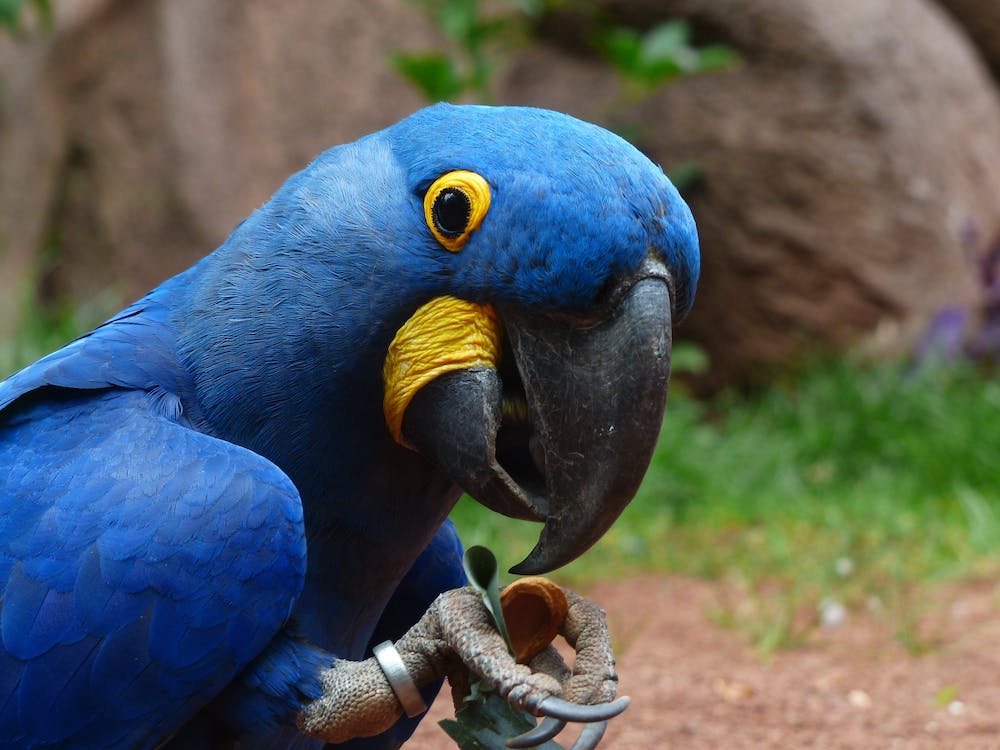How do I know if this is my bird?

Identifying your bird with confidence
Can you honestly say that, if your bird was in a cage full of similar birds (species, sex, and colour) that you could unhesitatingly point to one of them and say, “That’s my bird!” If your bird escaped and was handed in to a local animal shelter or veterinary clinic, is there any way that you can be contacted to come and get him/her? If you are buying or selling a bird, can you be confident that you are handling the bird that you want? If you are involved in a legal dispute over the ownership or origin of a bird, can you prove which bird is which in a court of law?
If your answer to these questions is “No”, then you may need to consider ways of identifying your bird and proving ownership. This article discusses the different means of doing this, how they are done, and the benefits and disadvantages of each.
Physical appearance and behaviour
In some cases, a bird can be identified by their physical appearance (an unusual species, a unique colour, or colour pattern, or a physical distinction such as a deformed or missing appendage) or by a unique behaviour. There are several cases where ownership of a disputed bird has been determined by the bird’s ability to say something truly unique about that bird, something that only the owner knew about. The important thing with these distinctions is to have a record somewhere of the distinguishing characteristic – perhaps photographs or a recording of the bird.
Of course, these characteristics may only be of value if you have been able to contact the finder of your bird, or the current holder. Relying on a bird’s appearance and/or behaviour has limited value or appeal for someone worried about their bird’s loss, or for someone wanting to purchase or sell a bird.
Leg rings and bands
It is a common practice to place a leg band or ring on birds. Closed rings (rings made of a continuous piece of metal with no join) can usually only be placed on a bird when a chick, and therefore are valuable pieces of evidence as to the origin of that bird. Wild-caught birds, unless taken from the nest as chicks, cannot have a closed ring applied. Split rings (a piece of metal that is split on one side and the ends are squeezed together with pliers) can be placed on a bird of any age and are not as definitive as proof of ownership. Some are quite sturdy, made of stainless steel. Others are soft and malleable, being made of aluminium or plastic.
There are several problems with leg rings:
- Split rings made from aluminium or plastic can be squeezed by the bird’s beak, the edges forced to overlap, and then the ring compresses around the leg. This effectively acts as a tourniquet, cutting off the circulation below the limb and resulting in the loss of the leg (and pain, suffering and often the death of the bird).
- Any leg ring can be caught in a piece of wire or a branch, trapping the bird and causing injury. This is particularly a problem with over-sized rings.
- Any leg ring can trap debris between the skin and the ring, again causing a tourniquet-like effect. This is particularly noticeable in budgies with Scaly Face Mite when the legs are affected, and the skin thickens.
- Over-sized rings can fall off!
- Leg rings are too small for owners’ names and addresses. They often only have the breeder’s or bird club initials and an identifying number. While this can be proof of ownership or as a means of identifying a bird for sexing purposes, they have limited use in tracing ownership of lost birds. If you don’t have the leg ring number written down in your records, the ring is just a ring in the event of a dispute over ownership.
- Unscrupulous people can remove leg rings (although heavy duty rings on large birds such as macaws are obviously difficult to get off). Once the leg ring has been removed and / or replaced, there is little proof of prior ownership.
- So, leg rings and bands have their place, but bird owners must recognise their limitations and beware of potential dangers in their use.
Microchipping
A microchip is a safe permanent method of electronic identification. The chip itself is very small – about the size of a grain of rice – and has a unique number that is detected using a microchip scanner. The microchip number is recorded on a microchip database registry with details about the animal and owner. Pet owners need to ensure their contact details are recorded on the database against their pet’s microchip number. Should your pet wander or become lost, vets, animal shelters and local councils can scan your pet for a microchip and contact you via the database. A microchip is a passive transponder that uses radio-frequency electromagnetic fields to transfer data from the transponder (that contains electronically stored information) for the purposes of automatic identification. Passive, in this case, means that it does not require a battery but instead is powered by the radio-frequency electromagnetic energy produced by the scanner used to read it. This technology is also known as RFID – radio-frequency identification – and has been accepted around the world as one of the most reliable means of identifying animals. Unlike a bar code, the microchip does not need to be within line of sight of the scanner and may be embedded in the animal itself.
The scanner used to read the chip presents an inductive field that excites the coil and charges the capacitor, which in turn energises and powers the silicon chip. The silicon chip then transmits the data via the coil to the scanner, allowing the operator to read the identification number.
Barring rare complications, birds are not affected physically or behaviourally by the presence of a microchip in their bodies.
There are several advantages to microchips:
- They do not cause any harm to the bird, nor can they be caught on wire or branches.
- They require surgery to remove them, so fraudulently changing the identification of a bird is much more difficult.
- They can (and should) be registered on a national database, linking the owner’s contact details to the microchip number. These registration details can be changed in the event of sale, or the owner changing address, so that the information remains current. (Remember that, without a current database, a microchip number is just that – a number!)
- Virtually all veterinary clinics, council pounds, and animal shelters have scanners, so that lost birds can be scanned for a microchip when they are handed in. The national databases can be contacted 24 hours a day, 7 days a week and can link an owner to a bird in a matter of minutes.
The major disadvantage of microchips, at this time, is that they must be inserted into the breast muscle over the bird’s keel (in very small birds this may be just under the skin). Although they are about the size of a large grain of rice, the needle used to insert them is quite large. For this reason, many veterinarians prefer to anaesthetise a bird before implanting a microchip. However, newer technology has reduced the size of the microchip and when these new chips are more readily available anaesthesia might not be required (except in very small birds e.g. those under 50g).
Avian vets now recommend that bird owners consider having their birds microchipped and registered on national databases (some bird owners are having their birds microchipped but not registered. This defeats the main advantage of microchipping!) So long as the bird’s owner has kept the registration details on the database current, lost birds can be identified and returned and disputes over ownership resolved. If a bird is microchipped but has not been listed on a national animal registry, the owner can still register that bird for a small fee on one of the registries by having the bird scanned to confirm the microchip number and then filling out an avian subscription form and lodging those details with the relevant registry.
Bibliography
Doneley B (2018) Avian Medicine and Surgery in Practice: Companion and Aviary Birds, 2nd ed. CRC Press
RSPCA Australia believes that captive-bred wild animals should not be kept in a home environment or for companion purposes unless the species has been clearly identified as being suitable for this purpose. It is important that animals living in a home environment can live a good life. This means providing for their physical health and ensuring opportunities to fully express their individual interests and experience good welfare. Inadequate care and husbandry are reported to contribute to common and serious welfare compromises in many captive wild animals living in home environments. For more information see our policy.
The reality is, however, that captive-bred wild animals are kept in home environments despite sometimes not meeting these criteria (e.g., some reptile and bird species). Because of this, the RSPCA has produced these articles on the care and welfare of a variety of commonly kept captive-bred wild animals. The aim is to help people better understand their animals as individuals and provide them with care that keeps them healthy and provides opportunities for positive mental experiences as much as possible in captivity.
Wild animals must not be taken from the wild to be kept as companion animals (pets).
Was this article helpful?
This work is licensed under a Creative Commons Attribution-NonCommercial-NoDerivatives 4.0 International License.



